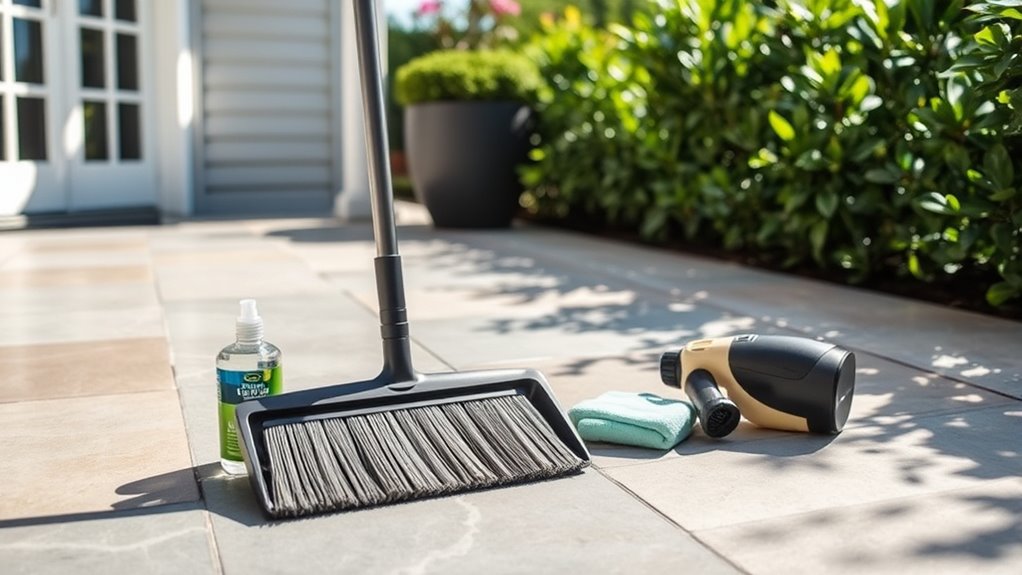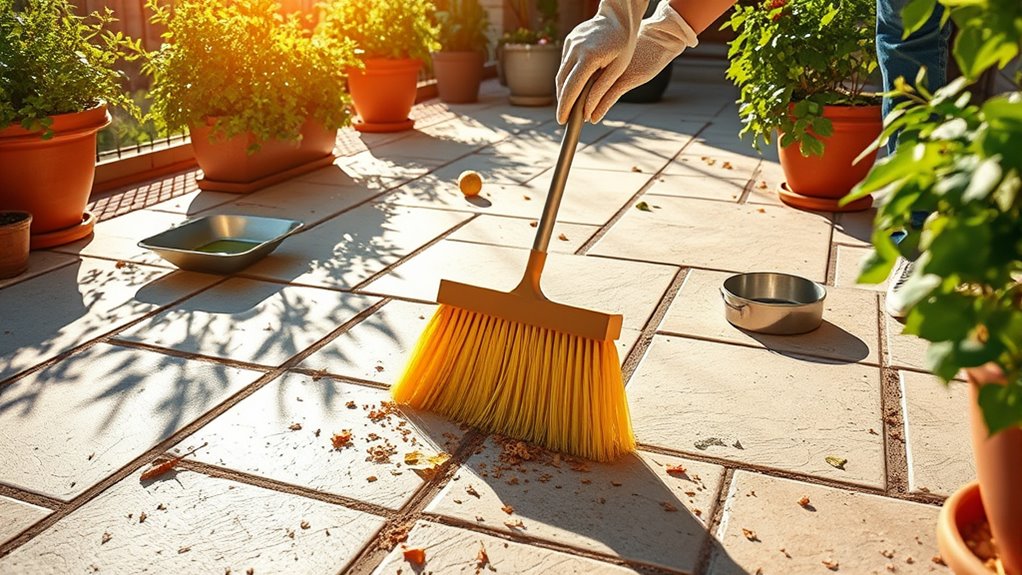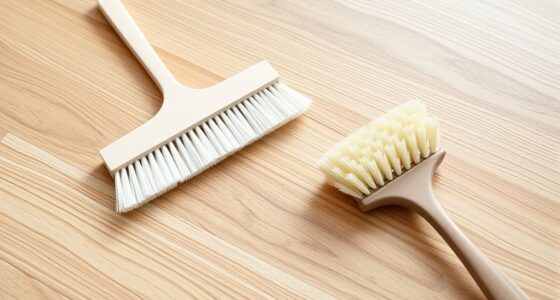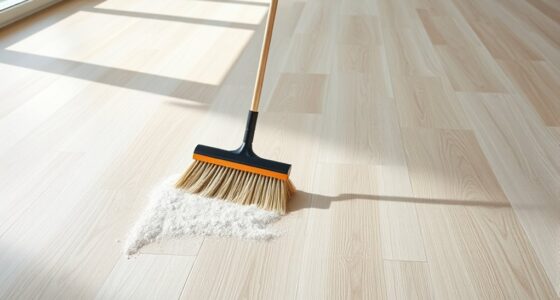Each week, spend ten minutes checking your outdoor sweeper to keep it running smoothly. Inspect brushes and housing for debris, tangles, and dirt, cleaning or replacing as needed. Look at wheels and rollers, removing obstructions and lubricating moving parts. Empty dust containers, clean filters, and wipe the exterior. Finally, do a quick test to verify everything moves freely and suctions strongly. Stay with us to discover more tips for maintaining your equipment at its best.
Key Takeaways
- Inspect and clean brushes and housing to remove debris and prevent wear.
- Check wheels and rollers for lodged dirt and lubricate moving parts.
- Empty dust compartments and clean filters to maintain suction power.
- Examine power cords or batteries for damage and replace if needed.
- Conduct a quick test to ensure smooth operation and effective cleaning.

Keeping your sweeper in top shape requires regular maintenance, and a weekly care routine is essential for ideal performance. When you commit to consistent sweeper maintenance, you ensure your outdoor cleaning tools work efficiently, saving you time and effort. A quick 10-minute weekly checklist can make all the difference in maintaining peak performance and extending the lifespan of your equipment. Start by inspecting the brushes and brushes’ housing; clear out any debris, tangled hair, or dirt buildup that may hinder their rotation. Dirty or worn brushes can reduce cleaning effectiveness, so replacing or deep-cleaning them periodically helps maintain power and efficiency.
Next, check the wheels and rollers. Debris often gets lodged in these parts, causing uneven movement and potential damage. Remove any stuck dirt or pebbles, and lubricate moving parts if necessary. Keeping the wheels in good condition ensures smooth maneuverability across your patio surface. Take a moment to examine the vacuum’s filters and dust compartments. Dirty filters limit airflow, reducing suction power, so cleaning or replacing them weekly keeps your sweeper performing at its best. Empty out dust bins or debris containers, and wipe down filters to prevent dust buildup that can clog the system.
Don’t forget to inspect the power cord or battery if your sweeper runs on electricity or batteries. Look for signs of wear, fraying, or corrosion, and replace faulty parts promptly. Properly maintaining your power source prevents unexpected breakdowns and ensures consistent operation. As part of your outdoor cleaning tips, keep the exterior of your sweeper clean and free of dirt or grime. Wipe down the housing and control panel with a damp cloth to prevent dirt accumulation that could interfere with controls or vents. Keeping your equipment clean also makes it easier to spot potential issues early.
Additionally, checking the performance of the motor and brushes regularly can help you identify early signs of wear or malfunction, ensuring your sweeper continues to operate efficiently. Finally, perform a quick test run after completing these steps. Run the sweeper on a small patch of your patio to confirm that brushes rotate smoothly, wheels move freely, and suction remains strong. This quick check allows you to catch any issues before they turn into bigger problems. Incorporating these simple steps into your weekly routine ensures your sweeper stays in top shape, delivering efficient outdoor cleaning results every time. When you follow these outdoor cleaning tips, you’ll find your patio stays cleaner longer and your equipment lasts longer, making your outdoor maintenance easier and more effective.
Frequently Asked Questions
Can I Use a Regular Broom Instead of a Sweeper?
Yes, you can use a regular broom instead of a sweeper. Manual alternatives like a broom are affordable and easy to find, but they may take more time and effort to clean larger patio areas. The pros include cost savings and simplicity, while the cons involve less efficiency and potentially missed debris. If you have a small patio, a broom works fine; for larger spaces, a sweeper saves you time.
How Often Should I Replace the Sweeper Bags or Filters?
You should replace sweeper bags and perform filter maintenance every 1 to 3 months, depending on usage. Don’t worry about frequent replacements; modern bags and filters are designed for durability. Regular bag replacement and filter maintenance keep your outdoor sweeper running efficiently, ensuring ideal cleaning. By staying consistent with these tasks, you’ll enjoy cleaner patios and longer-lasting equipment without the hassle of unexpected breakdowns or reduced performance.
Is It Safe to Use Outdoor Cleaners on My Sweeper?
Yes, it’s safe to use outdoor cleaners on your sweeper, but you should prioritize outdoor chemical safety. Always check the cleaning product selection to verify they’re compatible with your sweeper materials and won’t cause damage. Use gentle, environmentally friendly products when possible, and follow the manufacturer’s instructions. Avoid harsh chemicals that could corrode or ruin parts, and rinse thoroughly afterward to keep your sweeper in top condition.
What Should I Do if My Sweeper Stops Working?
When your sweeper stalls like a car stranded on the roadside, don’t panic. Start troubleshooting techniques by checking the power source, clearing any debris, and inspecting the brushes. Follow maintenance tips like lubricating moving parts and replacing worn belts. These small steps breathe new life into your machine, transforming frustration into confidence. With patience and care, you’ll have your sweeper rolling smoothly again, ready to conquer your outdoor messes.
Can I Use My Sweeper on Uneven or Gravel Surfaces?
Yes, you can use your sweeper on uneven or gravel surfaces, but verify its surface compatibility first. Use gentle cleaning techniques to avoid damaging the machine or pushing debris deeper. Move slowly and overlap passes to ensure thorough cleaning. Adjust the sweeper’s settings if possible, and stay cautious on rough terrain to prevent wear and tear. Proper technique helps maintain your sweeper’s efficiency and longevity on challenging surfaces.
Conclusion
Think of your patio like a well-loved garden—regular care keeps it thriving. Just last week, I skipped my weekly sweep, and by weekend, leaves piled up like a mini autumn. That’s when I realized a quick 10-minute routine isn’t just maintenance; it’s a way to keep your outdoor space inviting and vibrant. With consistent care, your patio will always be ready for spontaneous gatherings or quiet evenings under the stars.









